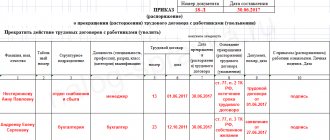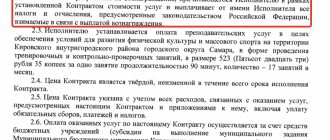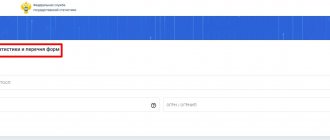The act form KS-17 is a document designed to confirm the existence of the fact of suspension (sometimes conservation) of construction work on a specific object on a specific site. In the article we will talk about KS-17 Construction Suspension Act and provide answers to frequently asked questions.
The form substantiates the basis that allows for mutual settlements between the parties to the agreement, since the contractor has received confirmation of the customer’s decision regarding the suspension or complete cessation of construction. The form was approved by the State Statistics Committee on November 11, 1999 by issuing its Resolution No. 100.
What is the KS-17 act used for?
With the help of an act of suspension of construction, the representative of the customer and the contractor express their mutual intention to temporarily stop the construction work being carried out at a specific site. The act is certified by the signatures of both parties and explains the reasons for the suspension, as well as cost indicators regarding the planned expenses for construction work and the work actually performed at the time of suspension.
After preparing the act under consideration, participants in the suspended construction process should begin implementing the next stage, which involves determining the full range of works associated with the implementation of measures aimed at preserving the facility.
Particular attention is paid to determining the cost component, interconnected with the processes after the suspension of work (organization of security measures at a “frozen” facility, purchase of material assets, etc.) Preparation of the KS-17 act may imply both the process of terminating relations and their temporary termination.
If an investor appears in the relationship, then he may be asked to provide a financial resource specified by the investment contract.
In accordance with legislative provisions, the conservation process does not imply the termination of contractual relations in the field of construction of the facility, therefore, the parties are recommended to provide in advance in the contract the procedure for action in the event of a suspension of the construction process.
What kind of document is this
Resolution of the State Statistics Committee No. 71a dated October 30, 1997 indicates what kind of form KS-11 is - an act of acceptance of completed construction.
The signing of the act by both parties means that the construction work is completed. Before signing the acceptance certificate in form KS-11, the customer checks the facility, checking the design and estimate documentation. In addition, the parties draw up documents that reflect the actual volume of construction work and the results of measurements and research of the finished object. The list of applications is agreed upon by the customer and the contractor in advance - when concluding the initial contract agreement or government contract.
Who fills out the KS-17 act form
The form is drawn up by the customer who initiated the construction project when he or the investor party initiates a decision related to the termination of construction work. Drawing up an act requires preparing as many copies as the given situation requires. There are at least two of them – for the customer and the contractor; It is possible to provide the document to the investor (upon request).
The form must be kept in the accounting departments of the parties to the contract. To correctly fill out the provisions of the act on suspension of construction, the presence of data obtained on the basis of information from primary sources (forms KS-6, KS-6a) is required.
What is meant by suspension of a contract?
The concept of “suspension of a contract” is absent in the legislation. You can suspend the fulfillment of obligations under the contract. For example, performing work, providing services. There must be a reason for this.
We believe that the execution of the contract can be suspended by agreement of the parties.
What is meant by suspension of a contract?
The legislation does not contain the concepts of “suspension of a contract” or “suspension of a contract”. Such a mechanism is not provided for contracts.
In this case, the fulfillment of obligations under the contract can be suspended. For example, suspend the supply of goods or performance of work. As a general rule, the fulfillment of obligations can be suspended when <*>:
- the other party did not fulfill its obligations;
- it is obvious that the other party will not fulfill its obligations on time. Certain circumstances must indicate this.
Example LLC “A” entered into a supply agreement with LLC “B”. According to the agreement, LLC “A” must make an advance payment no later than 03/05/2020. LLC "B", in turn, must deliver the goods no later than 03/13/2020. As of March 12, 2020, LLC “A” has not made payment. In this regard, LLC “B” may suspend the fulfillment of its obligation to supply goods <*>.
It happens that the counterparty does not fulfill its obligations partially. Then the fulfillment of your obligations can be suspended in the relevant part <*>.
Note: In the situations described above, a party can not only suspend the fulfillment of its obligations, but also refuse to fulfill them and demand compensation for losses <*>.
Is it possible to suspend the execution of a contract by agreement of the parties?
It happens that both parties agree to suspend the fulfillment of obligations under the contract for some time. For example, in a lease agreement, the parties want to stipulate a period when the tenant will not use the premises. After this period, the rental will continue.
The legislation does not provide for a separate mechanism for such cases. We believe that, based on the principle of freedom of contract, the parties can agree on such a condition in the contract <*>.
An example of the wording of a condition in an agreement: “Non-residential premises are provided for rent for the period: from 01/10/2020 to 08/31/2020 and from 11/01/2020 to 01/09/2021. During the period from 09/01/2020 to 10/31/2020, the tenant does not use the premises. The tenant does not pay rent, utility and operating payments for this period.”
However, the following must be taken into account in relation to lease agreements. The tenant is obliged to pay rent until the premises are returned to the landlord <*>. The return of the premises is carried out according to the transfer deed or other transfer document <*>.
In this regard, during the period of a break in the lease, we recommend that you draw up a certificate of return of the premises to the lessor. If the lease continues - accordingly, an act of transfer of the premises to the tenant. The act will confirm that the premises were not really used by the tenant. It will also avoid a dispute about the need to pay for such periods.
In order to ensure timely acceptance and transfer of premises, we also recommend that the parties be held liable for avoiding these actions.
An example of the wording of a condition in an agreement: “The tenant undertakes to return the non-residential premises to the lessor on August 31, 2020 according to the acceptance certificate of the premises, and the lessor undertakes to accept it. For evading acceptance of the premises, the landlord pays a penalty in the amount of 0.5% of the monthly rent for each day of evasion. The landlord undertakes to transfer the non-residential premises to the tenant for temporary possession and use on November 1, 2020 under the acceptance certificate, and the tenant undertakes to accept it. For evading acceptance of the premises, the tenant shall pay a penalty in the amount of 0.5% of the monthly rent for each day of evasion.”
When can work under a contract be suspended?
You can pause work when <*>:
- the customer violates his obligations under the contract and this prevents the contractor from fulfilling the contract.
Example of a customer violation The customer did not provide the contractor with materials, equipment, technical documentation or an item that needs to be processed (processed);
- it is obvious that the customer will not fulfill his obligations on time. Certain circumstances must indicate this.
Example A contract has been concluded between LLC “A” (customer) and LLC “B” (contractor). The contractor began work on February 10, 2020. The customer must transfer material that is unique to the contractor no later than March 30, 2020. It will be used at the final stage of work. In the country where LLC “A” is located, from 03/01/2020 to 05/01/2020, the export of the specified material outside the country was prohibited. Until March 1, 2020, LLC “A” did not send the material to the contractor. LLC “A” will not deliver the material on time. The circumstances clearly demonstrate this. Accordingly, LLC “B” may suspend the work.
In a number of situations, the contractor is obliged to suspend work until it receives instructions from the customer. This must be done when the contractor discovers that <*>:
1) materials, equipment, documentation, things transferred by the customer are unsuitable or of poor quality.
Note! This rule is specific for design work. Thus, the contractor is obliged, before receiving instructions from the customer, to suspend design work if the following are poorly prepared: - design assignment; - a set of initial data necessary for the execution of the contract <*>;
2) the instructions given by the customer regarding the method of performing the work may lead to adverse consequences.
Note: The consequences may be unfavorable for both the customer and the contractor <*>;
3) there are other circumstances that pose a threat to the suitability or durability of the work result or in which the work cannot be completed on time. Such circumstances must be beyond the control of the contractor;
4) additional work is needed. They are not taken into account in the design and estimate documentation and entail an increase in the estimated cost of construction. In this case, the contractor is obliged to inform the customer about this. Work is suspended if a response from the customer is not received within 10 days. A different period may be established by law or agreement.
Note! As a general rule, the customer must compensate the contractor for losses caused by such downtime <*>.
Suspension of construction
For construction work, in addition to the above cases, an additional mechanism for suspending construction is provided. It differs in that:
1) suspends the normative period of construction <*>;
2) is not associated with technological interruptions in construction <*>.
Note: Technological breaks are periods when construction work is not carried out due to the impact of natural and climatic factors on working conditions and production technology <*>;
3) has independent grounds for suspending work. So, construction can be suspended <*>.
a) the contractor, if he has not been able to perform work for more than one month due to the lack of materials, equipment that the customer must provide, or due to the customer’s failure to pay for the work on time;
b) the customer, if he:
— plans to mothball the facility;
- wants to stop further construction;
— identified deficiencies in the contractor’s work that may threaten the safety and reliability of the construction site;
c) state supervision bodies, other government agencies in cases established by law;
d) other persons on the grounds provided for by law and (or) agreement;
4) requires special design. Thus, the suspension of construction is formalized by an act of establishing a date for the suspension of construction, and the resumption of construction is formalized by an act of establishing a date for the resumption of construction. The forms of acts are established in Appendix G to TCH 45-1.03-122-2015.
Note! Suspension of construction should be distinguished from mothballing a construction site. Conservation involves the suspension of construction for a period of more than 3 months. In this case, construction work is stopped, and the construction contract is terminated <*>.
When can you suspend the provision of services under a contract?
The provision of services can be suspended on general grounds when <*>:
- the customer does not fulfill his obligations under the contract. For example, the customer did not make an advance payment;
- it is obvious that the customer will not fulfill his obligations on time. Certain circumstances must indicate this.
Additional grounds for suspension may be provided for certain types of services. Thus, a telecommunications operator may suspend the provision of services to a subscriber, for example, when he has identified <*>:
— violations of the procedure for transmitting traffic related to the use of a subscriber number;
— signs of suspicious behavior of the subscriber.
In addition, the parties may provide the grounds for suspension of services in the contract.
An example of the wording of a condition in a contract: “The Contractor has the right to suspend the provision of educational services to the customer if the number of customer employees attending the seminar is less than 5 people for 3 classes in a row.”
Read this material in ilex >> *follow the link you will be taken to the paid content of the ilex service
Who signs the document form?
In most cases, the following persons participate in signing the act of suspension of construction work:
- head of the customer organization;
- head of the contractor company;
- chief accountants of these parties.
Sometimes authorized representatives of these parties can take part in the signing of the KS-17 act if there are powers of attorney issued for them accordingly. Signatures are recorded on the back of the form, where they are stamped.
Is it possible to modify the form?
Although the KS-17 form is approved by the State Statistics Committee, it can be modified without loss of content. In any case, the procedure for drawing up an act on the suspension of construction must be recorded in the accounting policy of the organization.
Important! Form KS-17 can be adjusted provided that the contents of all lines and columns remain unchanged.
The need to make additions to the COP-17 act on the suspension of construction arises due to the specific nature of the relationship between the parties to the agreement. To reflect all information related to mutual settlements, the organization has the right:
- change the width of the columns (expand or narrow them);
- include additional lines;
- attach loose leaf sheets.
In order for the amended form to have legal force, it will be necessary to issue an order for each fact of amendment. If some columns of the document do not need to be filled out in a particular situation, it is recommended to put a dash or simply leave the column empty.
It is worth noting that when collaborating with several contractors at the same time, the form is drawn up for each of them separately. In other words, the number of acts of construction suspension will coincide with the number of signed contracts.
How is an act of form KS-17 drawn up?
The structure of the document contains the following components:
- A general purpose section, implying a list of data about the parties to the transaction (the title part of the KS-17 form);
- Front sheet tables;
- Similar tabular form from the back page;
- Final aspects and signatures of the parties.
The upper part of the front side of the KS-17 act form contains the information:
- full name of the investor organization indicating contact details, location address and registration details according to OKPO;
- similar information relating to the contractor and the customer company, separated by separate lines;
- the name of the construction project scheduled for suspension with the designation of its location address;
- data on the work contract indicating its essential details - date and number;
- a document that serves as the basis for performing construction work on a specific site;
- the basis (in the form of the title of the document), the action of which provoked the cessation of the work process at the construction site.
A separate line represents the name of the document itself, next to which its number and date of preparation are located.
The following is a tabular section containing data characterizing the construction project proposed for suspension. The table includes 12 columns to be filled out. Filling out the columns of the tabular part of the KS-17 form:
| Column number | Explanations for filling |
| 1 | Sequential numbering of table records. |
| 2 | Assignment with the name of the construction project, as well as the list of works and incurred costs caused by the process of stopping construction. |
| 3 | Object code, if assigned. |
| 4 | The date indicating the start of construction work. |
| 5, 6 | A monetary value that determines the total cost of work on site (both general and work related to construction and installation, which are divided into separate columns in the table). |
| 7, 8 | The contract (estimated) cost of the completed list of works performed at the time the construction process was stopped (there is also differentiation here by the full amount and due to construction and installation operations). |
| 9 | Actual costs according to the balance sheet information of the developer, incurred as of the date indicating the fact of termination of construction work. |
| 10 | The required amount of funds for mutual settlements with the contractor, including the share of work in progress. |
| 11 | A fixed component of the amount of money indicated in the previous column in terms of reimbursement to the contractor for expenses incurred upon termination of the contract related to unsold materials and structures. |
| 12 | The required cost of expenses allocated, if necessary, to perform work related to the conservation of the specified object. |
What is the procedure for filling
According to the rules, parties can use the approved forms of CC 11 from Resolution No. 71a. But since 2013, the use of unified forms is not mandatory. Both the customer and the contractor have the right to use the basic standard document and modify it in accordance with industry specifics. Rows, columns and cells approved by Goskomstat cannot be removed.
Instructions on how to fill out the standard form KS-11 in construction (during reconstruction, technical re-equipment):
- Indicate the details of the document - its number, date of preparation.
- Mark the contractor and its OKPO.
- Determine the customer and the contractor.
- Name the construction site and its address.
- Enter the authority that authorized construction procedures.
- Please note whether subcontractors were involved in the work.
- Write down the name and address of the designer who developed the design and estimate documentation.
- Indicate who approved the design documentation and when. This is usually done by the customer.
- Determine the construction period.
- Fill out one of the tables describing the indicators of the construction project. Option A is filled in for non-residential construction, option B is filled in for the construction of residential buildings.
- Indicate whether the end item meets the stated requirements. Refer to the acceptance documents of the equipment and the construction site itself.
- Fill out the table about the additional work included in the design estimates and actually carried out by the contractor - landscaping, landscaping, road surfacing.
- Determine the cost of the work.
- List the integral applications.
- Specify additional construction conditions (if necessary).
The agreed act is signed by representatives of the parties. When signing, indicate the name of the customer and contractor companies.
Sample
KS-2 - what is it in construction?
How KS-2 stands for and what its essence is, you can find out by studying the instructions for using and filling out forms in the “Album of Unified Forms” mentioned above. The specified document indicates that this form is drawn up on the basis of another KS form, namely, the Log Book of completed work KS-6a.
The full name of the KS-2 form is “Act of Acceptance of Completed Work.” However, in construction terminology you can also find other names for this form, for example, “execution” or “interest”. An example of interest rates in construction is shown in Figure 1.
Figure 1. Example of interest rates in construction
Thus, deciphering KS-2 in construction gives an idea of what a document of this form is used for. The main function of KS-2 is to record the work performed at a particular facility. Moreover, an act of this form can be drawn up for different types of construction and installation work and for different types of objects.
Interest rates in construction are of great importance due to the fact that other forms of the Constitutional Code are drawn up on the basis of this act. Such forms include, for example, KS-3 certificates. Sometimes the KS-2 form is used to reconcile data with the KS-6 and KS-6a logs.
What KS-6 is in construction and their decoding will be written in more detail later in the text. However, it should be said right away that these forms, as a rule, are drawn up by the work producers at the site, but sometimes they can also be drawn up by specialists from the estimate department or the technical and technical department.
Returning to the question of what interest is in construction, it is necessary to indicate that for an estimator this form is one of the fundamental ones in estimating. Therefore, the ability to draw up KS-2 acts is included in the list of job responsibilities of specialists in this profession.
The easiest and most effective way to learn about what interest is is from specialized literature, as well as in practice. After all, it is when drawing up KS-2 acts for a real object that knowledge is better absorbed.
In this article, it should be noted that interest in construction is a document on the basis of which not only the acceptance of work performed on site occurs. But it is also a form that serves as the basis for payment of the cost of work performed.
In addition, it should be noted that interest is a form, using the data of which some other forms from the list of KS are compiled. For example, a certificate of the cost of work performed KS-3. Sometimes, as noted above, KS-2 serves as the basis for reconciliation and preparation of KS-6a and other forms.
How to draw up a sample interest rate depends in each individual case on several factors: the source of financing, the type of construction project, the type of construction and installation work, etc. However, due to the fact that the KS-2 form is unified, there are many common features in its preparation for all objects.
Thus, percentage of completed work is a complex process. However, this process is one of the most important both in estimating and construction.





